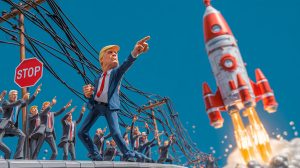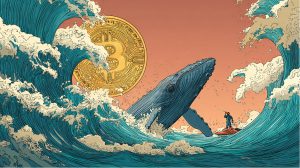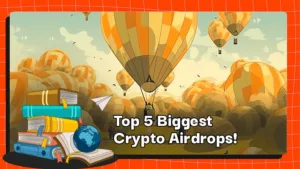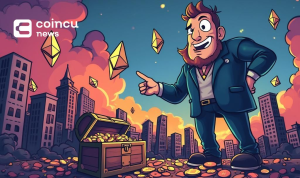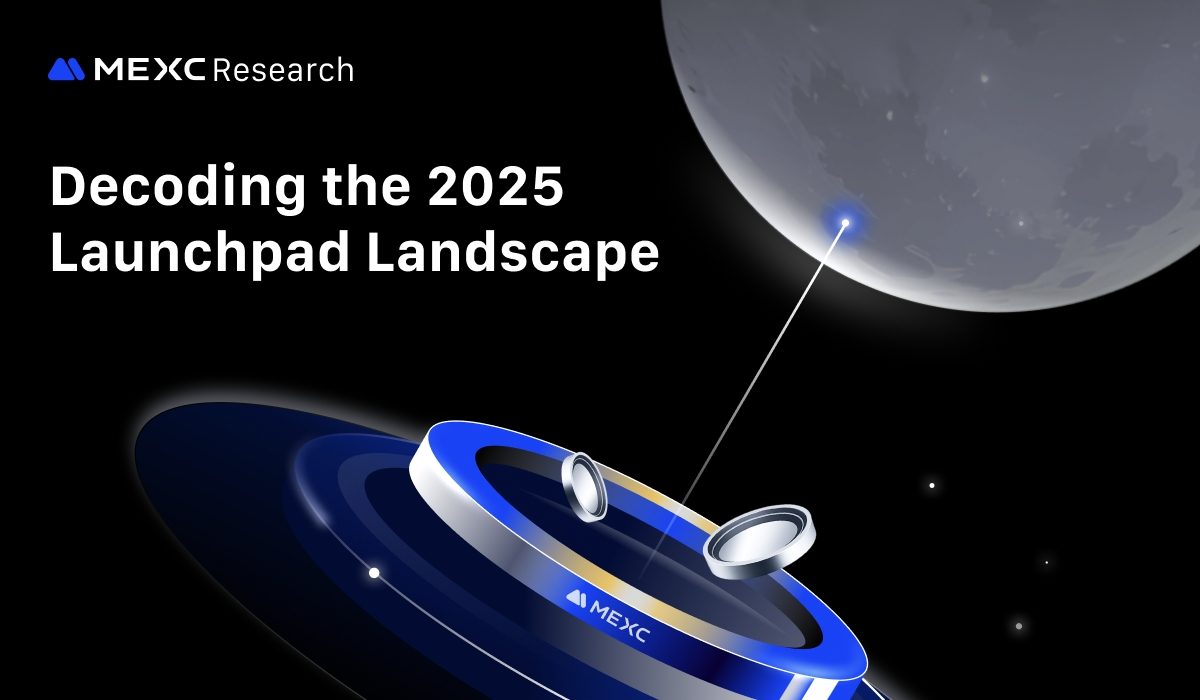Non-fungible tokens embody a progressive step forward in the ongoing evolution of financial systems. By embracing the digital representation of assets, NFTs challenge conventional norms, fostering a dynamic and inclusive financial landscape. Today, let’s find out with Coincu what NFT is through the article What is an NFT?
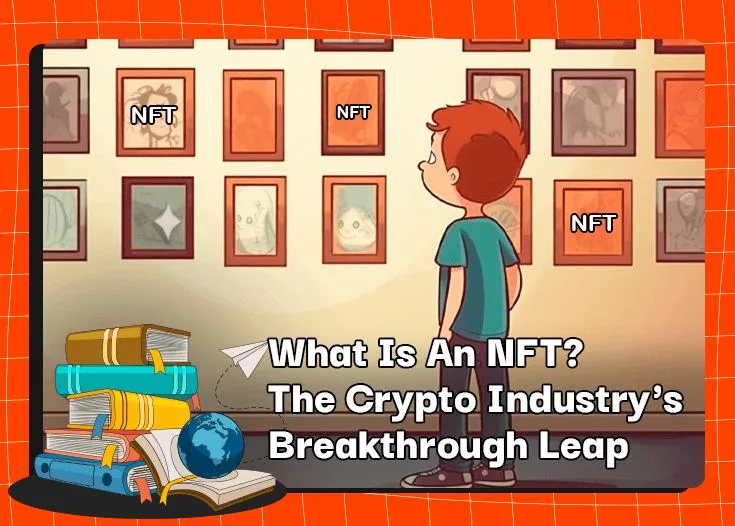
What is an NFT?
Unlike fungible cryptocurrencies, non-fungible tokens (NFTs) are individualized tokens with distinct identification codes and metadata, making each one exclusive in the ever-expanding digital market.
NFTs, often associated with blockchain technology, enable the tokenization of digital assets such as art, music, in-game items, videos, and more. The uniqueness of each NFT lies not in their appearance but in the encoded metadata, setting them apart from identical-looking tokens on the same blockchain. Despite the digital nature of these assets, NFTs provide buyers with ownership rights and built-in authentication, serving as proof of their exclusive possession.
One of the driving forces behind the recent surge in NFT popularity is their application in the buying and selling of digital artwork. In 2021 alone, the NFT market witnessed an astonishing worth of $41 billion, approaching the total value of the entire global fine art market.
The question arises: why are individuals willing to invest millions in digital assets that are easily accessible online for free? The answer lies in the concept of ownership – an NFT not only grants ownership of the original item but also offers a unique form of digital bragging rights highly prized by collectors.
Interestingly, even if multiple copies of the same digital file are created and corresponding NFTs are minted to represent ownership, each NFT is uniquely identifiable. This distinctiveness is derived from the special type of information, known as metadata, embedded within each NFT token. In essence, it’s akin to owning an exclusive edition of a trading card, where each card possesses its own serial number, making it distinguishable from others.
Going a step further, creators enhance the value and scarcity of their NFT collections by incorporating varying degrees of rarity. For instance, within a collection of 1,000 identical pieces, the creator might designate 10 with a different colored background and reserve only one with a patterned background. This strategic rarity adds an additional layer of investment appeal, enticing purchasers who seek the potential for increased value over time, assuming sustained demand for the collection.

How is an NFT different from a cryptocurrency?
While NFTs share a technological foundation with cryptocurrencies, their unique characteristics set them apart in the digital landscape.
In the realm of finance, physical money and cryptocurrencies are considered “fungible,” meaning they can be readily traded or exchanged for one another, and their values are equivalent. This fungibility, evident in the equal value of one dollar or one Bitcoin to another, establishes trust in conducting transactions within blockchain networks.
NFTs, however, operate on a fundamentally different principle. Each NFT possesses a digital signature that renders them non-fungible, eliminating the possibility of direct exchange or equivalence with other tokens. This distinct quality is a departure from the interchangeable nature of traditional currencies and cryptocurrencies.
The digital signature embedded in each NFT not only serves as a marker of authenticity but also contributes to its non-fungible nature. This uniqueness is a key feature that distinguishes NFTs from other forms of digital assets. Unlike cryptocurrencies, where one unit is indistinguishable from another, NFTs carry individualized digital identities, making them irreplaceable and incomparable to one another.
As the world delves further into the digital frontier, the rise of NFTs challenges traditional notions of exchange and value within the blockchain space. Their non-fungible nature adds a layer of exclusivity and authenticity to digital ownership, paving the way for new possibilities in the intersection of technology, art, and finance.
How does an NFT work?
NFTs, essentially cryptographic assets residing on a blockchain, are unique digital representations with individualized identification codes. Their creation involves a process known as minting, wherein the NFT information is securely recorded on the blockchain. This meticulous procedure often employs smart contracts, facilitating ownership assignment and managing transferability.
These digital tokens derive their value from market dynamics, adhering to the principles of supply and demand. Unlike traditional cryptocurrencies such as Bitcoin or Dogecoin, NFTs represent not only digital entities but also tangible real-world assets like artwork and real estate. The tokenization of physical assets enhances efficiency in transactions and offers potential safeguards against fraud.
Developers engaging in NFT creation frequently rely on established blueprints to streamline the process and reduce costs. Ethereum, a trailblazer in the crypto space, introduced token standards, specifically ERC-721 and ERC-1155, providing a framework for developers to deploy their own NFTs on the Ethereum blockchain. Other prominent blockchains, including EOS, Neo, and Tron, have followed suit, introducing their own NFT token standards to encourage developers to contribute to their blockchain ecosystems.

As NFTs are minted, they receive a unique identifier directly linked to a blockchain address, ensuring each token’s distinguishability. Even when multiple tokens of the same item are minted, each possesses a unique identifier, publicly tying it to its owner’s address.
Crucially, NFTs stand apart not only due to their non-fungibility but also in the infrastructure supporting them. Unlike traditional cryptocurrencies, NFTs cannot be traded on conventional centralized or decentralized exchanges.
Tailor-made NFT marketplaces, such as OpenSea and Rarible, have emerged as the go-to platforms for enthusiasts to list and trade these unique digital assets. This decentralized approach marks a significant departure from the conventional trading avenues, reflecting the evolving nature of blockchain-based assets.
Benefits of NFTs
Market Efficiency
One of the most apparent benefits of NFTs lies in their ability to enhance market efficiency. By tokenizing physical assets, the sales processes can be streamlined, eliminating the need for intermediaries. NFTs, whether representing digital or physical artwork on a blockchain, empower sellers to connect directly with their target audiences, bypassing the traditional agent-centric model. This assumes, of course, that artists are well-versed in securely hosting their NFTs.
Investing Revolutionized
NFTs are not confined to the world of art; they are reshaping investment strategies as well. Ernst & Young, a prominent consulting firm, has pioneered an NFT solution for fine wine investors. This involves storing wine in a secure environment while utilizing NFTs to safeguard its provenance. Real estate, a traditionally complex and bureaucratic field, is also undergoing transformation through tokenization. Properties can be divided into unique sections, each represented by an NFT, allowing for simplified and efficient trading based on specific characteristics such as proximity to a lake or forest.
Business Ownership and Automation
Beyond tangible assets, NFTs are extending their reach into the realm of business ownership. Comparable to stocks, NFTs can represent ownership in a business. Unlike traditional stock ledgers, blockchain technology and smart contracts enable automated ownership transferals. Once an NFT share is sold, the blockchain manages the entire process seamlessly, offering a more efficient and transparent solution.
Identity Security
NFTs are proving to be a powerful tool for bolstering identity security. By storing personal information on an immutable blockchain, NFTs ensure that sensitive data cannot be accessed, stolen, or misused without the appropriate cryptographic keys.
Democratizing Investments
Another facet of the NFT revolution is the democratization of investing. Physical assets like real estate can be fractionalized, allowing multiple owners to share in the ownership of a property. This tokenization principle extends beyond real estate to assets like artwork, enabling shared ownership of valuable pieces. For instance, a painting need not have a single owner; instead, numerous individuals can purchase shares, increasing accessibility and potentially elevating the artwork’s value and revenue streams.
What is an NFT marketplace?
As the NFT landscape continues to evolve, a closer look reveals that most NFT marketplaces fall into one of three distinct categories, each catering to different needs and preferences within the digital asset space.
Open Marketplace
Accessibility is the hallmark of open marketplaces, where anyone can seamlessly sell, buy, or mint NFTs. Minting, the process of uniquely publishing a token on the blockchain, is typically facilitated by the marketplace. However, creators also have the option to independently mint their own works. This open approach encourages a broad spectrum of creators and buyers to engage in the NFT ecosystem.
Closed Marketplace
In contrast, closed marketplaces require artists to apply for membership, and the platform itself usually manages the minting processes. This model imposes more stringent controls on selling and trading, fostering a curated environment with a focus on quality and exclusivity.
Proprietary Marketplace
Proprietary marketplaces specialize in selling NFTs that are trademarked or copyrighted by the operating company. This exclusive approach sets them apart, offering a curated selection of digital assets under the company’s brand umbrella.
NFT traders often diversify their engagement by creating accounts and subscribing to multiple marketplaces. Staying informed about new NFT drops is crucial, and traders leverage platforms like Discord and Twitter, as well as specialized investing platforms such as Rarity Sniper and Rarity Tools, to receive announcements and insights. The release of highly anticipated NFTs triggers swift responses from investors eager to secure these digital assets.
Most marketplaces prioritize user experience, offering step-by-step guides to help users navigate their platforms effectively. Upon creating a marketplace account, users typically connect their wallets to facilitate transactions. Some platforms even allow users to set up new wallets directly on the website or use the marketplace’s proprietary wallet, often accompanied by incentives such as discounts or reduced additional fees.
How to buy NFTs?
Navigating the NFT market requires careful consideration and a step-by-step approach to ensure a secure and informed entry into this dynamic space.
Step 1: Acquire Cryptocurrency
Many NFTs can only be purchased with Ether (ETH), making ownership of this cryptocurrency a crucial first step. To get started, individuals need to set up a digital wallet capable of storing both NFTs and cryptocurrencies. Purchasing Ether is typically required, depending on the currencies accepted by the chosen NFT marketplace.
Step 2: Choose a Digital Wallet
Selecting the right digital wallet is essential for the safe storage of NFTs and cryptocurrencies. Users may need to purchase cryptocurrency, such as Ether, through platforms like Coinbase, Kraken, eToro, PayPal, or Robinhood. Following the purchase, they can transfer the cryptocurrency from the exchange to their preferred wallet.
It’s important to research wallet options, considering features, fees, and ongoing support. Transaction fees should be carefully weighed, as most exchanges charge a percentage of the transaction when buying crypto.
Step 3: Understand the Risks
Entering the NFT market involves a level of risk due to its volatile nature. Even experienced investors can be deterred by the market’s highs and lows. Prospective NFT buyers should have a clear understanding of the process and be aware of the associated risks.
Step 4: Open a Crypto Exchange Account
To participate in the NFT market, the first step is to open an account with a crypto platform or exchange. Different platforms offer varying services, so it’s crucial to research and choose one that aligns with individual preferences in terms of features, fees, and ongoing support.
Step 5: Set Up a Crypto Wallet
A crypto wallet is necessary to store the keys granting access to digital assets. Users are provided with a unique seed phrase or recovery phrase, essential for wallet access. Safeguarding the seed phrase is crucial, as losing it results in the loss of wallet access.
Wallets can be either hosted on an exchange or operated independently. Independent wallets grant users full responsibility for their wallet and private keys. On the other hand, if the digital wallet is hosted by an exchange, the exchange acts as an intermediary for crypto transfers, holding private keys and ensuring asset security.
Examples of NFT marketplaces
OpenSea: A Beginner-Friendly Hub
Launched in 2017, OpenSea stands as one of the oldest NFT platforms, boasting a diverse collection of art, music, photography, trading cards, and virtual worlds. It supports Ethereum, Solana, Polygon, Avalanche, and BNB, providing a wide range of options for users. OpenSea is known for its user-friendly interface, allowing beginners to set up an account quickly and start exploring NFTs. The platform charges a transaction fee of 2.5%, making it an attractive choice for those new to the NFT scene.
Rarible: Empowering Users with RARI Tokens
Rarible facilitates the buying and selling of art, collectibles, video game assets, and NFTs. Users can engage with Ethereum, Polygon, Tezos, and Immutable X on this platform. Notably, Rarible introduces a decentralized decision-making process by issuing its native token, RARI, allowing holders to vote on company decisions. The platform’s 2021 partnership with Adobe enhances metadata verification for digital content, including NFTs, making it a compelling choice for those seeking a decentralized yet well-connected marketplace.
NBA Top Shot: NFTs for Basketball Enthusiasts
For basketball enthusiasts, NBA Top Shot offers a unique experience by allowing the purchase of NFTs featuring iconic moments in basketball history. Managed by the NBA, this marketplace exclusively offers video clips, play highlights, and art from both the NBA and WNBA. While purchases can be made with credit/debit cards or select cryptocurrencies, fees are applied to the purchase price. NBA Top Shot provides a trustworthy platform for those wanting to invest in memorable basketball moments.
Nifty Gateway: Exclusive NFT Sales and Celebrity Art
Known for hosting exclusive and high-value NFT sales, Nifty Gateway focuses on artwork, particularly pieces from celebrities and top artists. Acquired by Gemini in 2019, this marketplace uses an “open editions” system to create scarcity for new NFT releases. Nifty Gateway accepts credit card payments, making it accessible for those looking to make substantial investments in high-end NFTs.
SuperRare: A Selective High-End Art Marketplace
Positioning itself as an art gallery within the NFT ecosystem, SuperRare stands out for its highly selective approach to NFT submissions. This platform focuses on high-end NFT artwork, avoiding “meme style” submissions. SuperRare charges 15% on the first sale of an NFT on the primary market and a flat 3% on every transaction, providing a curated space for those seeking quality and a more classical style in their NFT acquisitions.
Conclusion
NFTs represent a significant evolution from the fundamental concept of cryptocurrencies. While cryptocurrencies initially introduced a decentralized form of digital currency, the emergence of NFTs signals a transformative leap in modern finance systems, disrupting traditional asset classes and redefining the infrastructure that underpins financial transactions. Hopefully the article What is an NFT? of Coincu has helped you understand more about this vibrant market niche.
DISCLAIMER: The information on this website is provided as general market commentary and does not constitute investment advice. We encourage you to do your own research before investing.










